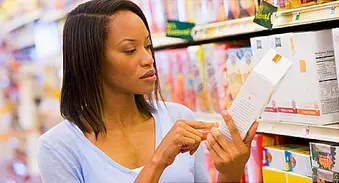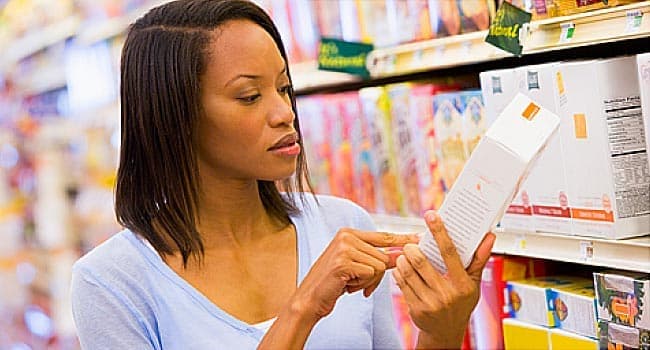Quiz: What’s in Your Food?


Some red food dye is made from bugs.
- True
- False
The idea that an insect adds a pink blush to candies, ice creams, yogurts, fruit juices, cheeses, and even butter makes some people, well, buggy. Others think of the red cochineal bug as a natural food coloring. Either way, it appears safe but can cause reactions in a small number of people. The FDA requires that "cochineal extract" or "carmine" be listed on the label.
"Pink slime" is:
- Waste left in meat grinders
- Beef treated with ammonia
- Coloring in hamburger
"Pink slime" is the nickname for "lean finely textured beef" -- beef trimmings sprayed with ammonia gas to kill things that can make you sick, like E. coli and salmonella. It's then mixed with ground beef to make it cheaper. In 2012, public uproar over "pink slime" pressured chains such as McDonald's, Taco Bell, Burger King, and Safeway to ban it. Still, you can't tell from the label if meat in grocery stores contains it, just yet. Congress may enact a label law, but hasn't yet.
Which has the most salt?
- A slice of American cheese
- A cup of raisin bran cereal
- An ounce of potato chips
1 slice of American Cheese has 273 milligrams of sodium, almost twice as much as potato chips. Eating a lot of salt can raise blood pressure and lead to heart disease. Yet Americans eat more than twice as much as we should, largely because processed foods -- even sweet ones -- are loaded with it. Why? It's used to preserve, hold ingredients together, and enhance color as well as to add flavor.
Which cocktail contains something that also treats malaria?
- Scotch and soda
- Gin and tonic
- Mai tai
Quinine relieves malaria symptoms and puts the bitter flavor in tonic water, bitters, and some pre-dinner drinks and sodas. Legend has it that the gin and tonic was created by British officers who were looking for a tasty way to ease malaria in the tropics. Used in drugs, quinine can cause serious side effects, but not in the small amounts used in drinks.
You're more likely to gain weight from eating high-fructose corn syrup than table sugar.
- True
- False
There is a mistaken belief that high-fructose corn syrup primes your body to make fat. But corn syrup and table sugar are the same; they're both about half fructose and half glucose. So the problem is more likely too much sugar in any form. To cut back on the sweet stuff, skip foods that list sugar or high-fructose corn syrup as one of the first ingredients.
Xanthan gum is used to:
- Thicken marshmallows
- Keep oil and vinegar together
- Make chewing gum
If you eat store-bought salad dressings, sauces, ice creams, or baked goods, chances are you've eaten this common additive. It thickens and binds, or holds together, ingredients that would naturally separate. It is also used in gluten-free and low-fat recipes. It is most likely safe, though it has not been tested widely. It's made from bacteria that feed on corn and soy, so if you are severely allergic to either, you may want to eat foods with guar gum instead.
How many packets of saccharin a day are too many?
- Seven
- Nine
- 15
Artificial sweeteners have had a controversial past but today are believed to be safe if not overused. How much is too much to have in a day? The FDA says:• Around 15 packets of saccharinIf you're going "natural" or are concerned about how much artificial sweetener you're getting, flavored sparkling water can take the place of diet drinks. And if you have a condition known as PKU, or phenylketonuria, avoid aspartame because your body can't break down some parts of it.
Sulfites can cause:
- An asthmatic reaction
- An allergic reaction
- Both
Sulfites keep color in and bacteria out of foods like wine, dried fruits, frozen potatoes, fresh shrimp, and jams and jellies. They're safe for most people but can cause mild to life-threatening reactions in about 5% of people with asthma. To avoid them, skip foods that list sulfur dioxide, sodium or potassium sulfite, bisulfite, or metabisulfite as an ingredient.
Which additive may cause a burning feeling in the back of the neck?
- Red dye No. 2
- MSG
- Nitrates
MSG, or monosodium glutamate, brings out the flavor in canned soups, salad dressings, chips, and restaurant foods. (Think Chinese food!) Some people say it causes headaches, nausea, and neck tingling or burning -- though studies have not confirmed a link. If you want to avoid MSG, look for it on labels, eat mostly whole foods, and ask at restaurants if they use it.
Eating foods with nitrates and nitrites raises your cancer risk.
- True
- False
Nitrates and nitrites prevent spoiling and give taste and color to cured meats like hot dogs, bacon, sausage, ham, and lunch meat. They can also convert to a substance known to cause cancer in animals. Studies show that eating a lot of processed meats for 10 years doubles your risk of colorectal cancer. What's a lot of cured meat? For women, it's two slices of bacon or half a hot dog two to three times a week. For men, it's that amount five to six times a week, says a 2005 JAMA study. Even eating smaller amounts over time increases colorectal cancer risk.
"Laughing gas" is in:
- Canned whipped cream
- Packaged popcorn
- Processed cheese
This clear, slightly sweet gas -- known more formally as nitrous oxide -- is used to make engines run faster and make people relax in the dentist's chair. It is also added to food to make canned whipped cream light and airy and to propel cooking sprays. It's called laughing gas because of the feeling it gives when inhaled.
Sorbitol:
- Prevents ugly color changes
- Kills germs
- Cuts calories
This sugar alcohol is half as sweet as sugar, making it popular in diet candies, chewing gum, drinks, and other foods. It's also popular with people who have diabetes because it is absorbed slowly and is less likely to cause blood sugar spikes. So what's not to like? The gas, stomach cramps, and even diarrhea that can come from eating too much. Stick with less than 50 milligrams a day. Tip: Foods likely to have enough sorbitol in a single serving to cause a "laxative effect" must say so on the label.
Artificial food coloring makes children hyperactive.
- True
- False
Yellow dye No. 5 (tartrazine) -- used in gelatin desserts, candy, ketchup, hot dogs, and other foods -- has been blamed for causing hyperactivity. But both the FDA and the European Food Safety Authority say it hasn't been proved. Yellow No. 5 can cause hives or swelling, though rarely. To avoid artificial food colorings, skip foods that are not a color found in nature.
Air is a food additive.
- True
- False
Air puffs out cheese puffs, lightens breakfast cereals, and even fluffs up ice cream. Some brands of ice cream are almost 50% air, unlike their heavier (and richer tasting) premium cousins. This makes the airy brands lower in cost and calories. Air is a cheap and safe food additive.
